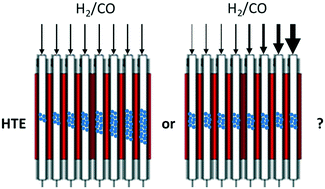Kinetic data acquisition in high-throughput Fischer–Tropsch experimentation
Abstract
The emergence of high-throughput experimentation gives new opportunities for accurate and rapid data acquisition for a wide variety of chemical reactions in different fields of application such as hydrocracking, isomerization and syngas conversion. Fischer–Tropsch synthesis is a challenging reaction to carry out due to its exothermicity, its wide range of products including heavy waxes, catalyst sensitivity to deactivation and the large number of parameters influencing the kinetics. Despite the accuracy gain brought by the most recent high-throughput technologies, numerous parameters need to be controlled for accurate data acquisition and correct comparison of catalyst performances. The present study shows that the high-throughput test strategy plays a major role and can affect significantly the accuracy and coherence of the generated data. For instance, when catalyst performances are measured for kinetic purposes, a commonly used method to vary the contact time (Wcat/FCO) is by loading the reactors with different amounts of catalyst. However, this method is not suited for catalysts that are difficult to reduce, since it has been shown that hydrogen space velocity during catalyst reduction has an influence on the degree of the reduction of the catalyst. Still this method might be preferred over the method of varying the syngas flowrate for a constant catalyst weight. The latter is time consuming and introduces deviations because of catalyst deactivation with time on stream. This issue becomes particularly important when liquid composition analysis is required, since even with a miniaturized high-throughput setup, we observed significant transitory periods on the liquid composition, due to wax accumulation in post-reactor volumes or catalyst evolution such as deactivation or surface reconstruction. Deactivation could, however, be limited by operating at low conversion levels or by running successive short tests.



 Please wait while we load your content...
Please wait while we load your content...